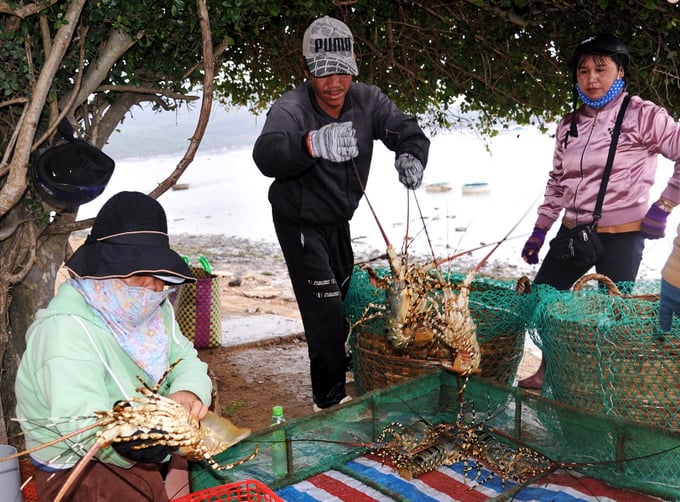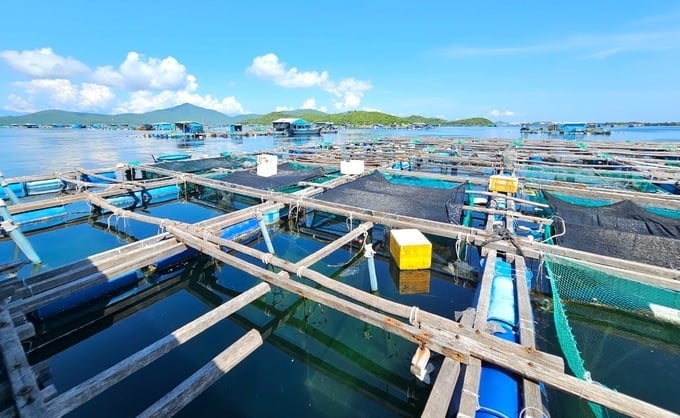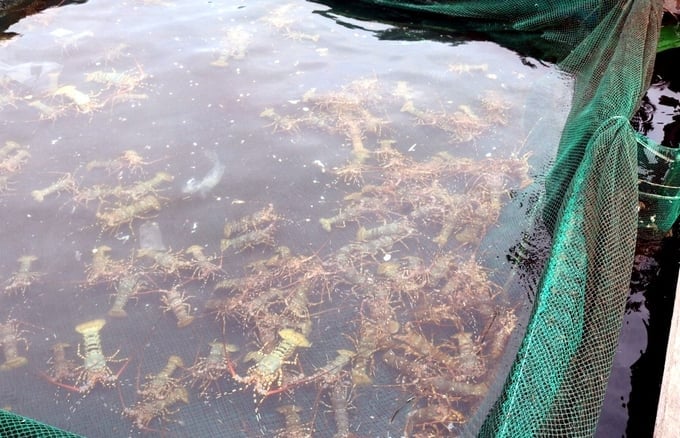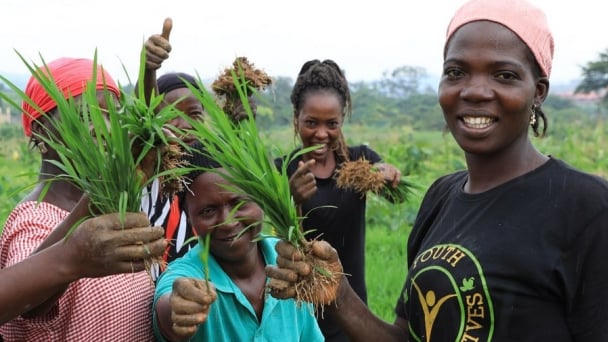May 16, 2025 | 05:14 GMT +7
May 16, 2025 | 05:14 GMT +7
Hotline: 0913.378.918
May 16, 2025 | 05:14 GMT +7
Hotline: 0913.378.918

Three months prior to this article, the prices of spiny lobsters ranged from 1.5 to 2.1 million Vietnamese dong per kilogram, depending on the type. Photo: KS.
Scheduled for November 15, 2023, the Ministry of Agriculture and Rural Development will host the Forum on "State of Breeding Stock, Feed, and Aquaculture Supplies; Tracing Product Origin and Sustainable Development Solutions for Vietnam's Aquaculture" in Nha Trang city, Khanh Hoa province.
Forum Agenda: Management of lobster breeding stock, sustainable lobster farming solutions; Tracing the origin of lobsters and aquaculture products to meet market demands; Control of imported aquaculture breeding stock; Research and production of industrial feed, various supplies for aquaculture; the state of the seafood market at year-end and projected outlook for 2024.
Mr. Nguyen Anh Tuan, a lobster farmer from Binh Ba Dong village, Cam Binh commune, Cam Ranh city, Khanh Hoa province, disclosed that lobsters have primarily been exported to the Chinese market through unofficial channels. The product's market distribution is unstable due to its reliance on the varying demands of this market, causing fluctuations in the lobsters' purchasing prices by traders.
In practice, lobster farmers typically suffer from reduced prices despite high yields. "When supply is scarce during the winter, and with a strong demand in the Chinese market, prices of lobster meat are relatively stable. However, during the summer months between April and July every year, this market has lower demands, and traders acquire lobsters at lower prices," Mr. Tuan added.

Lobster farming in Van Phong Bay, Van Ninh district, Khanh Hoa province. Photo: KS.
Mr. Tran Minh Hien, head of the cage lobster farming cooperative in Khai Luong village, Van Thanh commune, Van Ninh district, Khanh Hoa province, believes that lobster farming has significantly improved the lives of many fishermen in the South Central coast. However, high-value lobsters face challenges in terms of marketing and consumption.
"Everyone is competing in lobster farming and sales. The market distribution and input for these lobsters are both unstable without any production linkages. Whenever lobster farmers achieve high yields, the prices are forced down. On the other hand, lobster feed suppliers also want to increase their selling prices," lamented Mr. Hien. Furthermore, he added that the lobster farming industry is currently on a downward trend, with failing efficiency.
Farmers in Phu Yen province also reported that the purchasing prices for lobsters are highly unstable. Accordingly, prices for locally harvested lobster are dependent on traders with the paradoxical reality of "high yield, low prices, and vice versa."
Moreover, the unstable lobster export market constantly places farmers in a challenging position. Namely, numerous lobster farming cages in Song Cau town were ready for harvest in June 2022. However, only a small number of traders purchased the harvested volume due to their dependency on the Chinese market. Moreover, the Chinese market has recently ceased the import of spiny lobsters, leaving the farmers in a struggle with traders.

Farmers are struggling due to a lack of output for lobster exports. Photo: KS.
According to several shrimp feed suppliers and businesses involved in lobster purchases, China has reinforced their regulations concerning the traceability of spiny lobsters' origins since August 2022. Consequently, the newly updated regulations have caused significant difficulties in the process of consumption. Border clearance procedures between Vietnam and China are frequently restricted, resulting in substantial losses for live lobster export businesses.
The Ministry of Agriculture and Rural Development recently received reports from lobster export businesses and Phu Yen province's Fisheries Association regarding China's temporary cessation of spiny lobster imports. In order to verify the reports and promptly resolve related challenges, thereby facilitating Vietnam's live seafood exports to the Chinese market, the Department of Quality, Processing, and Market Development under the Ministry of Agriculture and Rural Development dispatched correspondence to the Vietnamese Embassy and Trade Office in China, as well as the Nanning Customs Department under the General Administration of Customs of China.
As the Ministry of Agriculture and Rural Development awaits official responses from the General Administration of Customs of China, the Directorate of Fisheries strongly advised local governments to enhance and fortify management protocols with regards to lobster farming in order to ensure continued growth and mitigate potential losses.
Spiny lobsters in Khanh Hoa province are predominantly farmed in Van Phong Bay, Van Ninh district. According to the Van Ninh district's Economic Department, local farmers are currently operating approximately 35,000 lobster cages. Notably, 17,000 of these cages, or nearly 50%, are dedicated to spiny lobster farming, mainly concentrated in Van Thanh commune.
Farmers reproted that traders have ceased purchasing spiny lobsters for the past three months, resulting in significant losses. "There is currently an abundance of lobster meat in the area; my family alone has 4 tons. Because we were unable to sell them, we still have to feed the lobsters daily, which means considerable expenses," shared Mr. Nguyen Xuan Hoa, a lobster farmer from Van Gia town.
According to Mr. Hoa, the family's harvested lobsters have reached the weight of 0.8 kilograms per lobster. Consequently, the family spends between 12 and 15 million Vietnamese dong daily on lobster feed. To date, the investment cost for each cage containing 70 lobsters is approximately 70 million Vietnamese dong, and with the family managing up to 80 cages in total, the expenses are substantial.

Farmers are anxiously anticipating the government's solutions to the consumption of spiny lobsters. Photo: KS.
Lobster farmers have expressed concerns over their ability to sustain if the issue persists, as escalating farming expenses without successful sales can lead to substantial losses. The farmers are currently forced to continue nurturing their lobsters in anticipation of the government's solutions to the consumption of spiny lobsters.
Mr. Nguyen Ngoc Y, Head of the Van Ninh district's Economic Department, reported that there are approximately 150 tons of harvest-sized spiny lobsters (approximately 0.7 - 1 kilogram each) in the district. It is estimated that at least 400 tons of marketable lobsters will be available until the year's end. Recent challenges have hindered the export of lobster to China, resulting in delayed procurement by traders and potential financial losses for local farmers.
As reported by the farmers, the current price range for spiny lobsters fluctuates between 1.05 and 1.1 million Vietnamese dong per kilogram, depending on the type. This price range stands in contrast to that of three months prior, which ranged from 1.6 to 2.1 million Vietnamese dong per kilogram.
In response to the challenges, the District Economic Department advises farmers to closely monitor market developments and focus on maintaining suitable stocking densities in addition to ensuring comprehensive registration and declaration with relevant governmental bodies. Furthermore, owners of lobster farming facilities are suggested to refrain from acquiring marketable lobsters without clear verification of their breeding stock's origin. Sellers of breeding stock spiny lobsters are requested to provide documentation and invoices to confirm the origin and quality.
To address the amassed inventory of spiny lobsters, Mr. Nguyen Ngoc Y suggested local governments to implement measures and facilitate the consumption of lobsters.
Over the long term, both spiny lobsters and local leading aquatic products must establish a secure value chain from production to safe consumption. On the other hand, there is a need for enhanced support in connecting purchasing and preliminary processing centers with cooperatives, aquaculture groups; issuing production unit codes, and origin tracing to improve the supply chain of sustainable, safe aquatic products.
Mr. Nguyen Tri Phuong, Deputy Director of Phu Yen province's Department of Agriculture and Rural Development, reported that the province has over 112,000 lobster farming cages. However, local farmers have focused on farming blue lobster within the last few years. Consequently, the number of spiny lobster is relatively small, accounting for only 10% of the total output. The province is expected to harvest at least 600 tons of lobsters by the start of the Lunar New Year, which includes 60 tons of spiny lobsters.
A recommendation to the Ministry of Agriculture and Rural Development regarding lobster exports
Mr. Nguyen Trong Binh, Director of Binh Thom Seafood Company Limited located in Cam Ranh city Khanh Hoa province, which specializes in purchasing and exporting spiny lobsters to the Chinese market, stated that China is Vietnam's largest importer of spiny lobsters. However, the Chinese market has limited its import of live seafood since the eight month of the lunar calendar. Consequently, this market only allows 40 trucks containing prawns, crabs, snails, and fish, to cross the border per day. As a result, the amount of exported lobsters has significantly dropped. Additionally, Dong Hung city's Customs has increased their inspection rate to 50% of each batch of exported goods. Namely, for 1 ton of exported spiny lobsters, the local Customs will perform inspection on approximately 5 quintals. Moreover, due to the perishable nature of spiny lobsters, the delay caused by inspections has led to severe losses for export businesses.
Mr. Nguyen Trong Binh added that after the Chinese market reinforced its regulations, Vietnamese exporters of spiny lobster have faced significantly lower sales. As a result, Mr. Binh proposed the Ministry of Agriculture and Rural Development to negotiate with Chinese Customs in order to alleviate the issue, ensuring an expeditious clearance process for all commodities, with a focus on spiny lobsters.
Translated by Nguyen Hai Long

(VAN) Data from 10,000 farming households will help professionalize production organization and support the implementation of the One Million Hectares Program for High-Quality, Low-Emission Rice Cultivation.

(VAN) FAO Director-General QU Dongyu marks International Day of Plant Health at NENA conference.

(VAN) Deputy Minister of Agriculture and Environment Hoang Trung affirmed that floriculture and ornamental plants are a growing industry that receives significant global attention.

(VAN) The three staple crops dominating modern diets – corn, rice and wheat – are familiar to Americans. However, fourth place is held by a dark horse: cassava.
/2025/05/10/4037-3-223011_495.jpg)
(VAN) Remote sensing technology is becoming an indispensable tool in monitoring resources, developing modern agriculture, and protecting the environment in Vietnam.

(VAN) The trash bag used on fishing vessels can withstand rough sea conditions, including level 8 to level 10 winds and waves. Notably, it can be hung anywhere on the boat.

(VAN) African leaders launched the Kampala Declaration on Building Resilient and Sustainable Agrifood Systems in Africa, marking a bold step toward transforming the continent's agriculture.